Welcome to our mini teaching guide on suffixes! In this post, you’ll find many different tools to help you teach suffixes to your child, as well as downloadable resources and activities. Let’s dig in!
What Is a Suffix?
A suffix is a word part that is placed at the end of a base word. Common suffixes include ED, ING, and EST. Take a look at more suffix examples below.
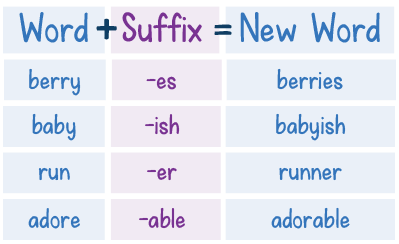
A suffix often transforms a word into a new part of speech. In the examples above, baby (a noun) is changed to babyish (an adjective); run (a verb) is changed to runner (a noun).
The Four Most Common Suffixes
The most common suffixes are S, ES, ED, and ING. These four suffixes are the most useful for beginning readers and spellers to learn because they appear frequently in words, and their meanings are easy to understand and remember.

Suffix S and ES indicate plurals.

Suffix ED indicates past tense.

Most often, suffix ING is added to verbs to indicate that something is happening in the present.
Interested in seeing more suffixes? Here’s a list of 30 common suffixes you can download and print.
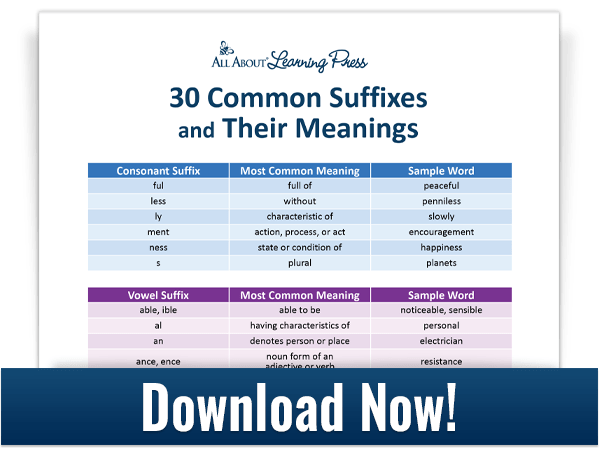
Adding Suffixes Is Different from Adding Prefixes
When adding a prefix to a word (Check out our mini guide on teaching prefixes!), you simply add the prefix to the beginning of the base word (as in unhappy). The spelling of the base word never changes. Super easy, right?
But adding a suffix to a word isn’t quite as straightforward. That’s because when you add a suffix, the base word often changes. For example:

Thankfully, there are some solid guidelines to follow when adding suffixes to words. Before we dive into those rules, though, let’s take a quick look at the two types of suffixes.
Two Types of Suffixes
You may have noticed on the free download that the suffixes are divided into two categories.

It’s important for kids to recognize whether a suffix is a consonant suffix or a vowel suffix since the rules for adding them to base words are different.
Rules for Adding Suffixes
Rule 1: Add a consonant suffix directly to the base word.

Rule 2: Check the base word before adding a vowel suffix.
Here are the first three guidelines we teach for adding vowel suffixes.
- If the base word ends in two consonants, just add the vowel suffix.

- If the base word has 1 syllable, 1 short vowel, and 1 final consonant, double the final consonant before adding the vowel suffix. (We teach this as the “1-1-1 Rule.” Although it may sound complicated, this rule is actually quite easy to follow when you have an understanding of syllable division rules.)

- If the base word ends in a Silent E , drop the E before adding the vowel suffix. (Again, this is an easy rule to understand: you don’t want to have two E’s in a row, so you have to drop the first E.)

Rule 3: If the base word ends in a single Y, change the Y to an I before adding the suffix.
(This rule applies to both consonant suffixes and vowel suffixes.)

There are more rules regarding vowel suffixes, but they apply to a smaller number of words. We teach them thoroughly and incrementally in All About Reading and All About Spelling, with plenty of hands-on practice.
What does hands-on practice look like? We use letter tiles for demonstration, and then we move on to interesting activity sheets!
Printable Activities for Learning about Suffixes
Would you like to see some examples? Here are a few great suffix activities from All About Reading and All About Spelling.
Have you started teaching suffixes to your child yet? How is it going? Let me know in the comments below!




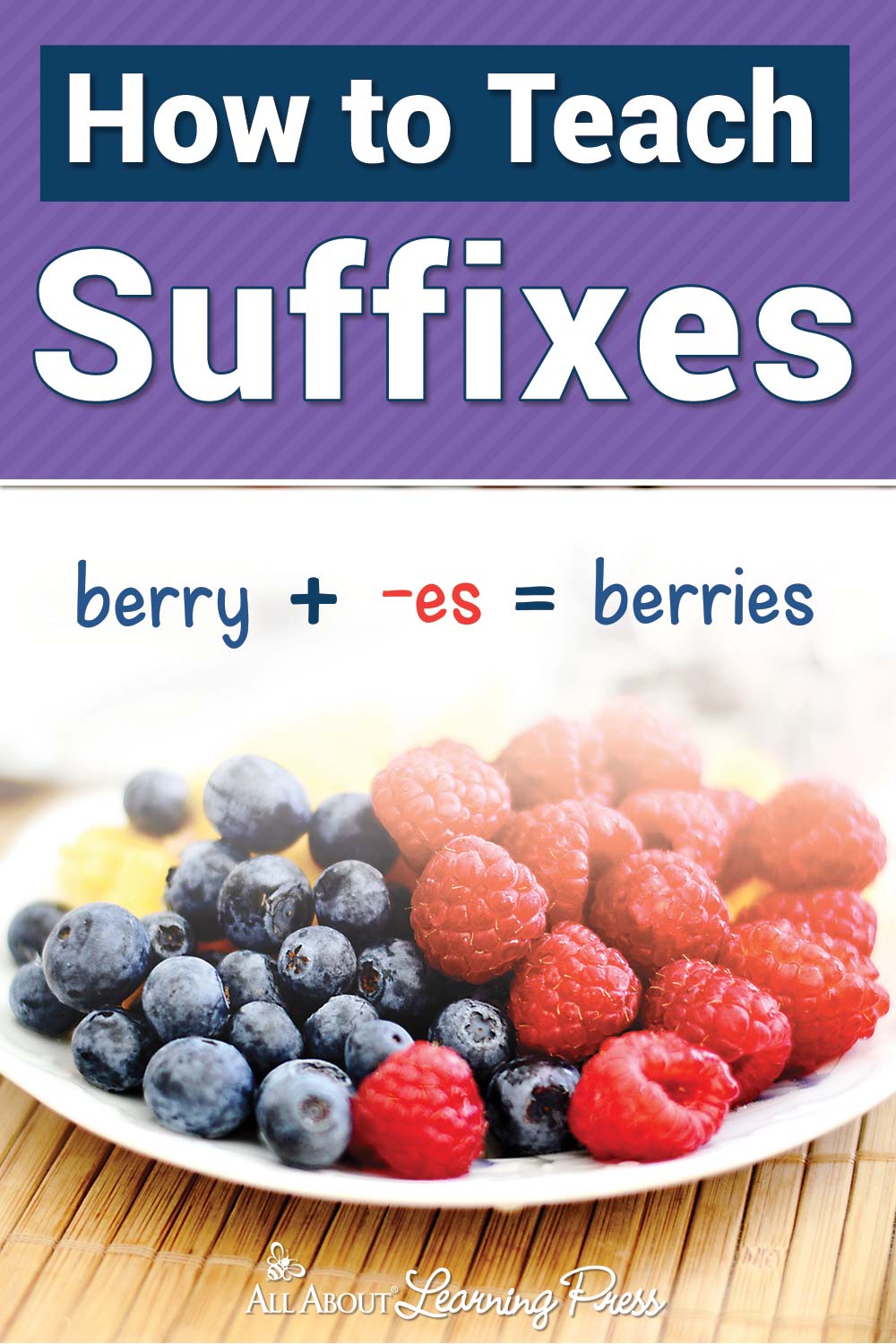












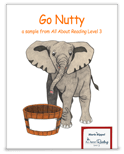
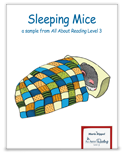
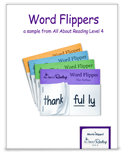
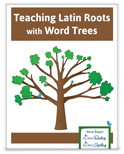
Brenda
says:I am working on Level 3 with my daughter. On Level 3, Step 16, Word Analysis we divide the word lucky into two syllables, luck y. This doesn’t seem to follow the Syllable Division Rules #1-4. Can you explain why we divide the word before the y.
Robin
says: Customer ServiceBrenda,
I’m happy to help.
Rules #1 and #4 obviously don’t apply, since lucky is not a compound word and does not end in a consonant plus LE.
Rule #2 may look like it might apply, but we don’t typically split consonant teams for syllable division. The would could be divided as luc-ky, which gives you the same sound, but splitting that CK isn’t the best.
Rule #3 is the one that applies, counting the CK as a one consonant and based on the “usually” part of that rule. If you recall from All About Spelling Level 2, if dividing a word with one consonant between two vowels with the consonant going with the second vowel does not form a real word, the consonant should be moved to the first vowel. So, the word becomes luck-y.
Also, if you refer to Step 12 in AAS 3, page 69, you see that it teaches “Sometimes the friendly vowel suffix runs off with the last consonant.” Lucky is one of those times that the vowel suffix doesn’t take the consonant, but just stays alone. Luck-y.
I hope this helps! Let me know if you need more information, though.
Peggy Ullery
says:Fabulous resources to pair with AAS-Thanks!
Robin
says: Customer ServiceYou’re welcome, Peggy! The teaching in this blog post is just a taste of the more in-depth teaching All About Spelling does for suffixes.
Alfonsine Mushinga Dikuua
says:Thank you, it’s is useful.
Ann
says:Thank you! I will be tutoring a child this summer and these activities will be helpful!
Robin E.
says: Customer ServiceYou’re welcome, Ann!
ALICE
says:GREAT CHART!!!!! BEST I’VE SEEN.
Robin E.
says: Customer ServiceThank you, Alice!
Lynn
says:Thank you. Most helpful–even for struggling learners!
Robin E.
says: Customer ServiceYou’re welcome, Lynn!
e
says:The downloads are clear, informative, and very helpful. Both the teachers and the students are very grateful for your help and great downloads!
Melanie England
says:Great Lessons!
shana
says:thanks!!
bassem younsi
says:really interesting. I would be thankful (see the suffix ful !! i’m just joking) if you don’t mind providing more printable activities.
best regards
Arielle
says:Is there a printable visual for the 1-1-1 Rule somewhere like the other posters?
Robin E.
says: Customer ServiceArielle,
I’m sorry, no. We do not have a poster for the 1-1-1 Rule. There is a chart (not colorful) for the rule included in All About Spelling Level 3 though (the level the rule is taught).
Maria Sangiolo
says:Please add me to your mailing list to receive your blog.
Robin E.
says: Customer ServiceI signed you up, Maria. You should have received a welcome email.
Karen Mahon
says:Almost ready for my young students to start spelling dictation. Your rules and teaching materials explain the why and how words accommodate suffixes and how the doubling rule works. You know the t in kitten is doubled because when you break kitten into syllables you hear two soft vowels i and e. Short vowels are closed vowels so, kit and ten to give both vowels soft sound. Then, there is to confirm, your 1-1-1 rule. “ If the base word has 1 syllable, 1 short vowel, and 1 final consonant, double the final consonant before adding the vowel suffix. (We teach this as the “1-1-1 Rule.”).
We have the above rules, the alphabet sounds and a sound wall posted to help word pronunciation and spelling. Thank you for all your help.
What is so easy to one, is true work for another. Understanding sound is essential.
Robin E.
says: Customer ServiceThank you for such a detailed comment, Karen! I love that you have things posted on the walls for easy reference.
ohene
says:magnificent stuff
Robin E.
says: Customer ServiceThank you!
alice
says:Great stuff on prefixes and suffixes. I love the rules!
Robin E.
says: Customer ServiceThank you, Alice! Glad you like it.
Wimasha Wijesinghe
says:Thank you. It’s very helpful to me.
Robin E.
says: Customer ServiceYou’re welcome, Wimasha. I’m glad this was so helpful.
Chevanise coburn
says:Hello
Sol
says:I loved ALL of your activities! Thank you SO much for sharing them!
Robin E.
says: Customer ServiceYou’re welcome, Sol. It’s wonderful to hear that you appreciate the activities so much!
Julia
says:I can’t wait to use some of the games on here! We will be doing them this summer.
Robin E.
says: Customer ServiceGlad you like them, Julia!
Sonia
says:This would be awesome!!
Jasleen Johal
says:Thanks for the wonderful resource!!
Brianna
says:Thank you for this!
Robin E.
says: Customer ServiceYou’re welcome, Brianna!
Sarath Ratnayake
says:very clear. Thanks.
Robin E.
says: Customer ServiceYou’re welcome, Sarath.
Bronwen Bell
says:Thank you for an excellent read. Very informative
Robin E.
says: Customer ServiceYou’re welcome, Bronwen! I’m glad you found it informative.
Tambra Phillips
says:new information.
Katie
says:I love how this is so clearly taught to the student (and teacher!). It gives them the background knowledge needed to be able to tackle unknown words as they become independent readers. As a mom with years of elementary school teaching experience and a master’s in literacy education, I’m looking forward to beginning this program with my child!
Robin E.
says: Customer ServiceThank you, Katie! We appreciate your experience and insights on this.
sharmain
says:Hello Marie, I truly like like your activities. they are very interesting and seem pretty engaging for the kids.
Robin E.
says: Customer ServiceThank you, Sharmain!
Cheree
says:This info is great and I’m definitely downloading the activities on this page to do with my 1st grader!!
Robin E.
says: Customer ServiceGreat! Glad this will be helpful for your student, Cheree.
Cathy Carter
says:This looks like a really great site to use to teach suffixes and prefixes, but I am unable to download the many activities. Do you have any suggestions on how I can download these wonderful activities.
Robin E.
says: Customer ServiceI’m sorry you are having problems downloading our activities, Cathy. What device and browser are you using? What is happening when you try to download them?
I’m happy to help you figure out why it isn’t working. However, sometimes the easiest thing is to try a different device or a different browser.
sajjad
says:anyone can teach me english personaly
Shobha.
says:Nice